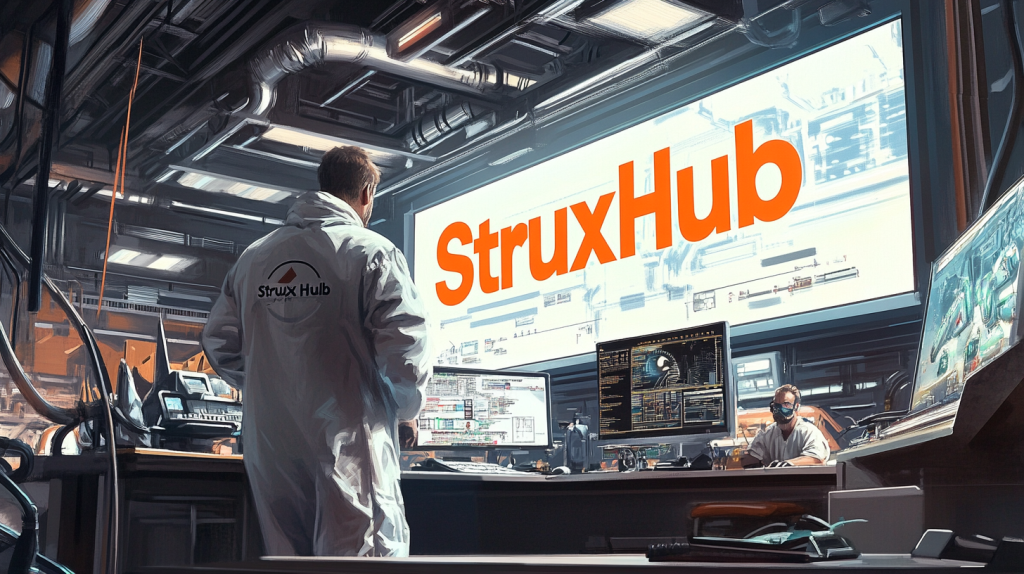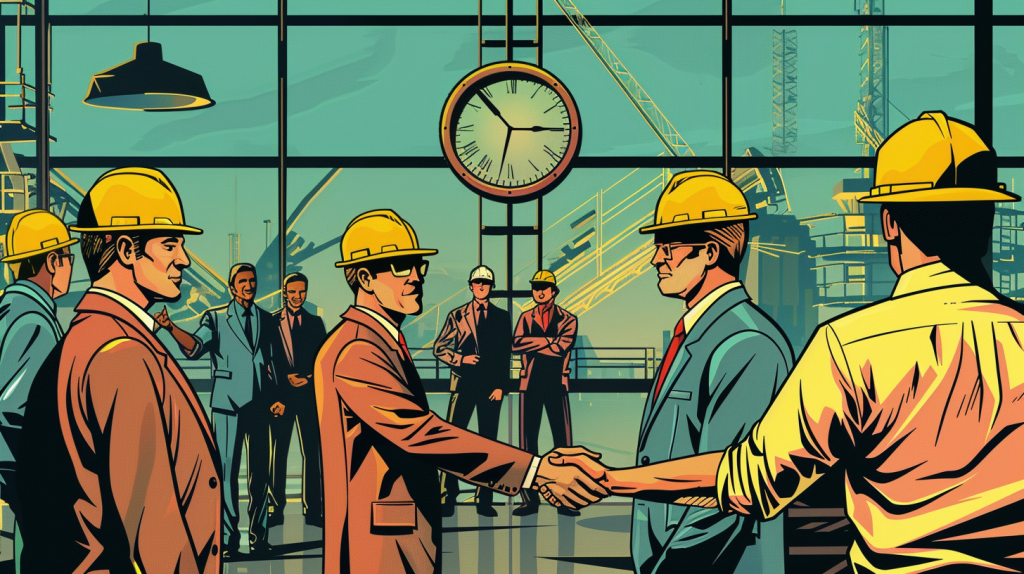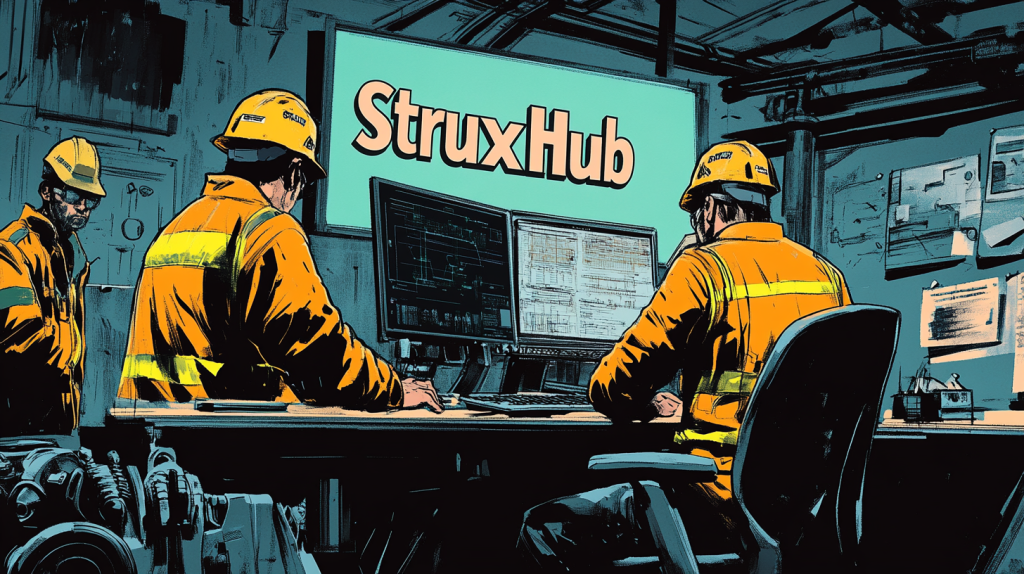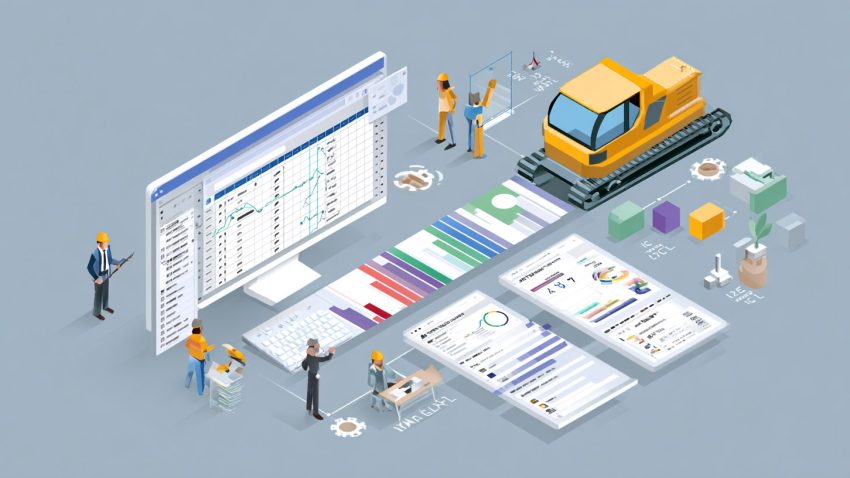Hyperscale Data Center Construction Management: How to Scale Construction Management Systems for Hyperscale Data Center Builds
Table of Contents:

Managing the construction of hyperscale data centers requires a level of precision, coordination, and scalability unlike any other infrastructure project. These massive facilities—powering cloud computing, AI, and enterprise networks—demand highly structured management systems that can adapt to complex workflows, vendor coordination challenges, and multi-phase deployments.
Without a scalable construction management system, hyperscale data center projects risk supply chain bottlenecks, workforce inefficiencies, regulatory non-compliance, and costly delays. Traditional project management methods—relying on spreadsheets, disconnected tracking systems, and manual communication—are no longer viable for these large-scale builds. Instead, leveraging cloud-based, AI-enhanced, and real-time data-driven solutions ensures seamless scheduling, vendor collaboration, and risk mitigation throughout the project lifecycle.
This guide explores the essential components of scaling construction management systems for hyperscale data centers, covering key challenges, best practices, and the role of advanced construction technologies like StruxHub in optimizing workflows.
What Makes Hyperscale Data Center Construction Unique?
Unlike conventional data centers, hyperscale facilities are built to support exponential scalability, often requiring hundreds of megawatts of power and vast cooling infrastructures. These projects demand specialized construction management systems that can handle multiple concurrent workstreams, global supply chain dependencies, and real-time compliance tracking.
Key Differences Between Hyperscale & Traditional Data Center Construction
- Project Scale & Speed – Hyperscale data centers require aggressive timelines, with some facilities needing to be operational within 12-24 months. This necessitates parallel workstreams, modular construction, and just-in-time (JIT) procurement.
- Vendor Complexity – Hundreds of contractors, suppliers, and specialized service providers must be synchronized to prevent scheduling conflicts and resource shortages.
- Regulatory & Compliance Factors – Hyperscale facilities must adhere to Uptime Institute Tier Standards, ASHRAE cooling guidelines, ANSI/TIA-942 certifications, and regional energy regulations.
- Data-Driven Project Tracking – Real-time monitoring, AI-powered predictive analytics, and digital twins are used to streamline decision-making, reduce risk, and improve forecasting accuracy.
Without an advanced construction management system, these challenges can lead to missed deadlines, cost overruns, and operational inefficiencies. Platforms like StruxHub help unify workflows, automate compliance tracking, and improve project transparency across all teams.
Related Articles:
Best Guide to Data Center Construction Management Software: Manage Scheduling, Deliveries, and Compliance for Hyperscale Projects
Data Center Construction Deliveries: Best Real-Time Tracking Solutions for Managing Data Center Construction Deliveries
Data Center Construction: Top Delivery and Scheduling Strategies for Redundant Power Systems in Data Centers

Key Challenges in Hyperscale Data Center Construction Management
Scaling construction management systems for hyperscale data centers involves overcoming unique industry-specific hurdles that can impact project timelines, efficiency, and overall success.
1. Managing Multi-Tier Scheduling & Parallel Workflows
- Hyperscale data centers require multiple workstreams operating simultaneously. Without proper coordination, worksite congestion, workflow clashes, and inefficient labor allocation can delay projects.
- Adopting dynamic scheduling tools allows managers to prioritize high-impact tasks, track progress in real time, and prevent timeline conflicts.
2. Vendor Coordination & Communication Breakdown
- With multiple subcontractors handling HVAC, electrical, networking, security, and infrastructure, clear communication is essential.
- Using a centralized construction management platform like StruxHub enables real-time updates, progress tracking, and automated scheduling adjustments for vendor teams.
3. Supply Chain & Procurement Delays
- Equipment shortages, material delivery disruptions, and long lead times for critical infrastructure components can stall progress.
- AI-driven predictive analytics help forecast demand, automate procurement scheduling, and recommend alternative suppliers before delays occur.
By addressing these challenges through scalable, integrated management solutions, project teams can maintain efficiency, reduce downtime risks, and ensure on-time delivery of hyperscale data centers.

Best Practices for Scaling Construction Management Systems
To optimize hyperscale data center construction, project managers must adopt scalable, technology-driven strategies that streamline workflows, enhance communication, and mitigate risks.
1. Implement Cloud-Based Construction Management Software
- Centralizing project data ensures seamless collaboration between remote teams, vendors, and on-site workers.
- Platforms like StruxHub, Procore, and Autodesk Build improve task automation, material tracking, and milestone reporting.
2. Leverage AI & Predictive Analytics for Scheduling & Resource Allocation
- AI-powered scheduling identifies bottlenecks, labor shortages, and potential construction delays before they occur.
- Automated workforce planning optimizes labor distribution across different phases, maximizing productivity.
3. Integrate Modular Construction for Faster Deployment
- Prefabrication of electrical systems, cooling units, and structural components off-site reduces on-site build times and improves quality control.
- Using a modular approach can cut hyperscale construction timelines by 30%.
By integrating these best practices, hyperscale data center projects can achieve greater efficiency, cost savings, and predictable execution timelines.
How Do Commissioning & Final Testing Fit Into the Schedule?
Commissioning is the final and most critical stage of hyperscale data center construction. This phase ensures that mechanical, electrical, and IT systems are fully operational, compliant, and ready for deployment. Unlike conventional buildings, hyperscale data centers undergo extensive multi-stage commissioning processes to meet high-performance uptime standards.
Key Commissioning Phases:
- Equipment Verification & Pre-Installation Testing – Ensures that backup generators, UPS systems, and cooling units meet manufacturer specifications.
- Integration & Functional Testing – Validates power distribution, security systems, and networking configurations.
- Full-Load Testing & Failover Simulations – Replicates real-world operating conditions to test resilience against failures and system overloads.
Using StruxHub’s commissioning workflow tracking, project teams can coordinate tests efficiently, prevent last-minute failures, and accelerate go-live timelines.
Related Articles:
Sustainable Data Center Construction: Best Green Building Practices for Sustainable and Mission-Critical Data Center Construction
Data Center Construction Compliance: Top Tools for Streamlining Permits and Compliance in Data Center Construction
Data Center Construction Delivery Coordination: Efficient Scheduling Strategies for Modular Data Center Equipment Installations
What Role Does StruxHub Play in Optimizing Hyperscale Construction Management?
StruxHub is designed to streamline hyperscale data center construction by providing an all-in-one platform for scheduling, vendor coordination, and real-time progress tracking. Traditional construction management relies on manual reporting, fragmented communication, and disconnected workflows, which can slow down hyperscale builds. StruxHub eliminates these inefficiencies by automating project oversight and optimizing execution strategies.
How StruxHub Enhances Hyperscale Construction:
- Real-Time Project Tracking – Ensures milestone adherence, contractor accountability, and automated workflow adjustments.
- AI-Driven Scheduling & Risk Forecasting – Identifies potential bottlenecks before they impact project timelines.
- Supply Chain Optimization – Monitors material deliveries, inventory levels, and vendor performance metrics to prevent procurement delays.
By integrating StruxHub, construction teams reduce inefficiencies, improve coordination, and accelerate hyperscale project delivery.
How Can Real-Time Data Improve Decision-Making in Hyperscale Construction?
In hyperscale data center construction, the ability to access and analyze real-time data can make the difference between a seamless project and costly delays. With so many moving parts—vendor coordination, supply chain logistics, workforce allocation, and compliance tracking—having immediate insights ensures that project managers can quickly adjust schedules, resolve conflicts, and optimize efficiency.
One of the primary benefits of real-time construction management systems is proactive issue resolution. Traditionally, project managers relied on manual reporting, which often caused delays in identifying bottlenecks. By the time issues were recognized, it was often too late to implement an effective solution without pushing back deadlines. Real-time dashboards eliminate this problem by providing instant visibility into project progress, workforce deployment, and potential delays.
For example, if a critical component shipment is delayed, real-time tracking alerts decision-makers immediately, allowing them to source alternate suppliers or adjust workflows before the delay impacts overall project completion. Similarly, if labor productivity drops on a specific worksite, managers can reallocate teams in real time, ensuring steady progress.
Construction platforms like StruxHub integrate these capabilities by providing automated progress tracking, live vendor updates, and predictive scheduling tools. With AI-powered analytics, project leaders can forecast potential risks and adjust resource allocation accordingly. The result is a more efficient, agile, and cost-effective hyperscale data center build that meets aggressive deadlines and reduces unnecessary expenses.
Related Articles:
Data Center Construction Management Software: How Advanced Construction Management Supports Edge and Hyperscale Data Center Development
Data Center Construction Document Control Solutions: How to Manage Contracts and Regulatory Documents in Data Center Construction
Best Guide to Data Center Construction Management Software: Manage Scheduling, Deliveries, and Compliance for Hyperscale Projects

Why is Integrated Workflow Automation Critical for Hyperscale Data Centers?
Hyperscale data centers require highly synchronized workflows to manage complex infrastructure deployments. Without automation, construction teams face communication breakdowns, scheduling conflicts, and inefficient labor distribution—all of which lead to costly overruns. Integrated workflow automation ensures that every phase of construction operates in sync, reducing human error and improving productivity.
One of the main challenges in traditional construction management is the fragmented nature of communication between vendors, subcontractors, and general contractors. Critical updates often get lost in email chains, causing misalignment between different workstreams. An automated system consolidates all workflow interactions into a single centralized platform, ensuring everyone has access to the latest updates, schedules, and project milestones in real time.
Another key benefit of workflow automation is task prioritization. Large-scale construction projects involve thousands of individual tasks that must be completed in a specific order. Automated scheduling ensures that dependencies are tracked, preventing teams from getting ahead of critical steps. For instance, networking infrastructure cannot be deployed before electrical systems are tested and verified—an automated system flags these dependencies, ensuring no phase is executed prematurely.
StruxHub’s integrated workflow automation tools help bridge these gaps by syncing vendor timelines, automating approvals, and ensuring regulatory compliance. By reducing manual workload and streamlining execution, workflow automation ensures that hyperscale data centers are built faster, smarter, and with fewer delays.
Related Articles:
Data Center Construction Deliveries: Best Real-Time Tracking Solutions for Managing Data Center Construction Deliveries
Data Center Construction: Top Delivery and Scheduling Strategies for Redundant Power Systems in Data Centers
Best Guide to Construction Management Software
Data Center Construction Delivery Coordination: Efficient Scheduling Strategies for Modular Data Center Equipment Installations
The Best Guide to Delivery Management Systems (DMS) for Commercial Construction

StruxHub
Experience the power of StruxHub today and witness firsthand how it can revolutionize your construction operations.
Unlock the Full Potential of Your Construction Projects with StruxHub
StruxHub enhances efficiency and coordination across all project phases, providing a single source of truth that eliminates silos and fosters collaboration. Real-time updates, financial management tools, and seamless commvunication features ensure that all team members and stakeholders are aligned and informed, reducing the risk of errors and delays. With comprehensive solutions for document management, risk mitigation, and quality control, StruxHub maintains project integrity and safety, while mobile access and integration capabilities further enhance project flexibility and efficiency.
StruxHub’s Key Features and Benefits:
- Advanced Delivery Management: Automate and optimize your delivery schedules, ensuring materials arrive just in time, every time.
- Site Communication: Utilize georeferenced maps and instant messaging to keep every team member informed and aligned.
- Construction Materials Management: Track inventory levels and manage materials procurement with ease, reducing waste and avoiding project delays.
- Construction Safety & Inspection Workflows: Implement customizable mobile forms for conducting safety inspections and managing compliance documentation effortlessly.
- Short-Term Scheduling: Visualize project tasks with detailed floor plans, linking each activity to specific locations for better planning accuracy.
- Construction Resource Management: Efficiently allocate personnel and equipment, maximizing productivity and reducing idle time.
StruxHub’s Product Offering:
- StruxHub Deliveries: Simplifies the coordination of incoming deliveries, ensuring materials and equipment are precisely timed to project needs.
- StruxHub Logistics: Offers intelligent site logistics planning, from crane scheduling to space allocation, for smoother operations.
- StruxHub Safety: Elevates on-site safety standards with easy-to-use tools for inspections, permits, and incident reporting.
- StruxHub Scheduling: Enhances project timelines with intuitive scheduling tools that ensure tasks are completed efficiently and on time.
With StruxHub, construction companies can look forward to a streamlined, more efficient project execution that delivers on time and within budget. Embrace the power of innovation and take your construction projects to the next level.
Don’t miss out on the opportunity to optimize your construction management processes with StruxHub. Sign up for a free demo today. Let’s build smarter, together.

FAQ
1.How does supply chain management affect hyperscale data center construction timelines?
Supply chain management plays a crucial role in the timely completion of hyperscale data centers. Given the scale and complexity of these projects, every delay in material procurement can disrupt the entire construction schedule. Components like HVAC systems, power distribution units, backup generators, and fiber optic cables have long lead times and must be sourced from specialized vendors.
A single delay in the supply chain can result in a domino effect. For example, if high-capacity cooling units arrive late, this can push back the installation of IT infrastructure, as the environment must be properly conditioned before equipment deployment. This is why proactive supply chain management strategies are essential. Project teams must leverage real-time tracking, AI-powered demand forecasting, and vendor diversification to minimize risks.
StruxHub integrates real-time material tracking and automated procurement alerts, ensuring that supply chain disruptions are identified early. By using predictive analytics, project managers can forecast potential shortages, secure alternate suppliers, and adjust timelines to prevent unnecessary bottlenecks. Effective supply chain management ensures that hyperscale data centers remain on schedule, within budget, and free from avoidable delays.
2. What are the most effective ways to coordinate multiple contractors in a hyperscale data center project?
Coordinating multiple contractors in a hyperscale data center project is a major challenge due to the sheer number of vendors involved, each specializing in different aspects of construction. Electrical teams, mechanical engineers, security system installers, and network infrastructure specialists must all work in sync—without interfering with each other’s progress.
One of the most effective ways to manage this complexity is through centralized communication and real-time coordination platforms. Traditional methods, such as email updates and weekly status meetings, are often too slow to keep up with hyperscale project demands. Instead, live progress dashboards, automated scheduling adjustments, and instant notifications help ensure that all contractors remain aligned.
StruxHub provides a vendor coordination hub, where all subcontractors can update progress reports, flag potential conflicts, and receive real-time schedule adjustments. Additionally, automation tools ensure that critical work dependencies are met before the next phase begins. This prevents issues such as networking teams arriving to install fiber optic cables before electrical infrastructure has been tested.
By using real-time coordination tools and clear contractor guidelines, hyperscale data center construction teams can ensure smooth collaboration, reduce scheduling conflicts, and accelerate project completion.
3. Why is predictive scheduling important in hyperscale data center projects?
Predictive scheduling plays a vital role in ensuring that hyperscale data center projects remain on track, on budget, and free from unexpected delays. Unlike traditional static scheduling, where teams follow a fixed timeline, predictive scheduling uses AI-driven analytics to anticipate delays, adjust work sequences, and optimize resource allocation dynamically.
A common issue in large-scale construction is unexpected labor shortages, delayed material deliveries, or unforeseen technical challenges. With predictive scheduling, machine learning algorithms analyze historical project data, real-time workforce availability, and supplier lead times to detect potential risks before they escalate. This allows project managers to make adjustments in advance rather than reacting to problems after they occur.
For example, if a storm is predicted in a region supplying key materials, predictive scheduling systems will flag this risk, allowing managers to order materials early or identify alternate suppliers. Similarly, if labor productivity drops due to staffing shortages, AI can reallocate workforce resources across different tasks, preventing bottlenecks.
StruxHub incorporates real-time predictive scheduling tools, helping construction teams stay ahead of potential issues by continuously analyzing project data and suggesting proactive solutions. By leveraging predictive scheduling, hyperscale data center developers can maintain efficiency, reduce uncertainty, and ensure smoother project execution.
4. How can construction management software improve compliance in hyperscale data centers?
Compliance is a critical aspect of hyperscale data center construction, as these facilities must meet industry regulations, safety standards, and environmental guidelines before they can become operational. Compliance violations can lead to project shutdowns, costly fines, and operational delays, making it essential for teams to have a reliable compliance management strategy.
Traditional compliance tracking methods—such as manual paperwork and periodic audits—are inefficient and prone to errors. Construction management software automates this process by digitizing compliance documentation, tracking regulatory updates, and ensuring that all contractors follow required protocols.
StruxHub enhances compliance management by automating documentation submission, flagging regulatory risks, and integrating inspection tracking tools. This ensures that all workstreams are aligned with Uptime Institute Tier Certifications, ASHRAE cooling standards, and ANSI/TIA-942 requirements. Additionally, compliance dashboards allow project managers to monitor inspection deadlines, required permits, and quality assurance benchmarks in real time.
By utilizing construction management software for compliance tracking, hyperscale data center projects can avoid regulatory setbacks, ensure worker safety, and accelerate project completion without legal complications.
5. What role does automation play in reducing labor inefficiencies in hyperscale projects?
Automation is key to reducing labor inefficiencies in hyperscale data center projects, where large workforces must operate in sync with strict project deadlines. Labor-intensive tasks, such as manual reporting, scheduling adjustments, and resource allocation, can lead to wasted time and decreased productivity.
By automating workforce management, construction teams can optimize shift planning, track labor productivity in real time, and eliminate redundant tasks. StruxHub’s workforce automation tools provide real-time labor tracking, automated task assignments, and predictive workforce planning, ensuring optimal efficiency throughout the project.
By leveraging automation, hyperscale data center developers can increase efficiency, reduce operational costs, and improve overall workforce productivity.




